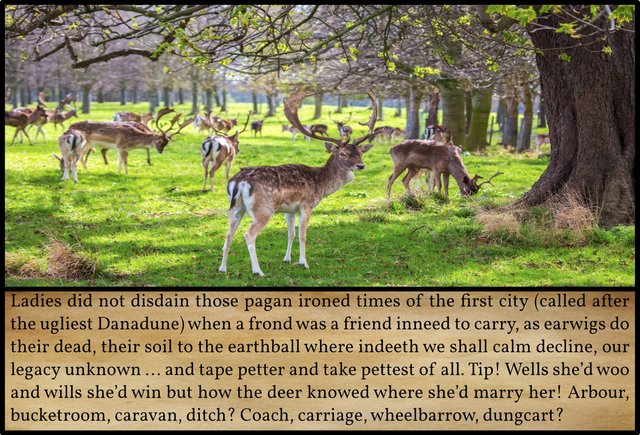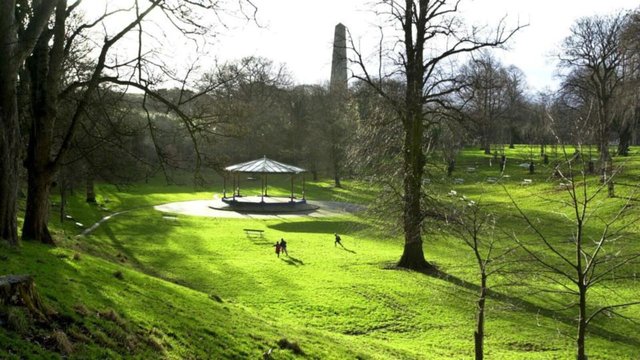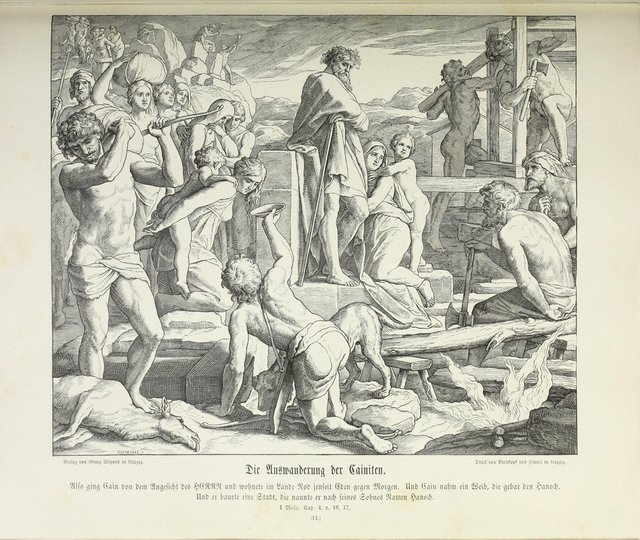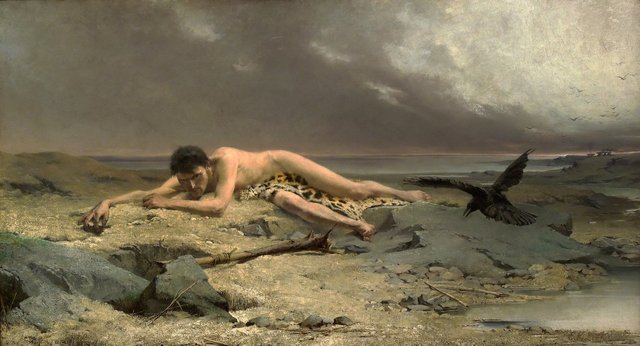Ladies did not disdain those pagan ironed times

HCE is dead and buried in a watery grave at the bottom of Lough Neagh. But in the preceding paragraph we received our first intimations that HCE’s earlier history is about to be repeated―not by HCE himself but by his sons Shem & Shaun. Our guide to this phase of Earwickian history is Kate, the elderly maid-of-all-works in HCE’s tavern―the same garrulous old woman who led us through the Museyroom in the first chapter. Kate is the compiler of the midden heap behind HCE’s tavern, in which all the history of the Mullingar House lies buried, patiently awaiting the trowel of some future archaeologist. The strata of this rubbish dump are like the pages of a book in which the whole history of Finn’s Hotel will one day be read. Of course, Kate’s dump also stands for Dublin itself―dumplan, as it is called in the next paragraph.
The Museyroom was, among other things, an outhouse―Waterloo doubling as water closet and loo―which also lies behind the tavern. Consequently, the present paragraph echoes the Museyroom’s allusions to defecation and masturbation―actions indulged in by HCE in the outhouse. Also, the crime for which HCE was executed seems to have involved a pair of maidens relieving themselves in the foliage in Phoenix Park amongst the fallow deer.
First-Draft Version
Usually we begin our analysis by examining the first draft of the passage, as recorded by David Hayman. This paragraph, however, was an afterthought on Joyce’s part. When he first drafted this chapter in 1923, the description of Earwicker feeding on his own fat (ie fasting) was followed by the account of Kate Strong, with no more break between them than a period. But between January 1924 and early 1927 Joyce revised this section, adding the following lines:
Ladies those times did not disdain when a frond was a friend in need to carry their soil to the erdball. Venuses were guffawably cheap, adonises vulcanoes guffawably eruptious and the whole wives world frockful of fickles. When, any human inyan you liked would take her godkin, or an even pair of hem, and prettily pray with him, or with hem even, long for luck, tapette and tape better and take pettest of all, but the deer knows who she’d marry. (JJDA)
There are clear echoes here of the Crime in the Park: the leaves (fronds) among which the two maidens (Venuses) make their toilet and with which they wipe themselves afterwards : their faeces (soil). The French tapette is slang for tongue or garrulous person, though other meanings may also be relevant: homosexual, faggot : mousetrap : fly swatter : carpet beater.

By 1927, when an early version of this chapter was published in issue 4 of Eugene Jolas & Elliot Paul’s transition, it included this passage:
Ladies did not disdain those pagan ironed times of the first city (called after the ugliest Danadune) when a frond was a friend indeed to carry, as earwigs do their dead, their soil to the earthball. Venuses were gigglibly temptatrix, vulcans guffawably eruptious and the whole wives’ world frockful of fickles. Fact, any human inyon you liked any erenoon or efter would take her bare godkin out, or an even pair of hem, and prettily pray with him (or with em even) everyhe to her taste, long for luck, tapette and tape petter and take pettest of all. Wells she’d woo and wills she’s win but how the deer knowed where she’d marry ! Arbour, bucketroom, caravan, ditch?Coach, carriage, wheelbarros, dungcart?
This is very close to the published version. According to the Dutch translators of Finnegans Wake Erik Bindervoet & Robbert-Jan Henkes, she’s win is a transmissional error for she’d win (McHugh 079.24). The s in wheelbarros is probably also a typo―it’s not in any of the drafts recorded on the James Joyce Digital Archive. Some of the added details complement the earlier allusions to the Crime in the Park: the fallow deer have been added : as has the Arbour in which the Crime is committed (standing in for the Garden of Eden) : and we have the dung[cart], both that of the maidens as well as HCE’s contributions in the Museyroom.

- the first city (called after the ugliest Danadune) In Thomas Josephus Lamy’s Latin commentary on Genesis, Commentarium in librum geneseos (1884), Joyce read: “Not until two hundred or three hundred years after the birth of Enoch did Cain found a city, to which he gave the name in honour of his elder son” (Lamy 1:257–258). Cain’s son Enoch is not to be confused with Seth’s great-great-great-grandson of the same name.
Dublin was originally a Scandinavian city. Ireland’s Vikings were often identified as Danes, wherever they actually came from.
Danu was the mother-goddess of the Tuatha Dé Danann, legendary invaders of Ireland. Lugh of the Long Arm (lugod! lugodoo!) was also a member of the Tuatha Dé Danann.
But why is this Danadune the ugliest?
- to carry, as earwigs do their dead According to Roland McHugh’s Annotations to Finnegans Wake, this alludes to the following passage in the Daily Mail (3 August 1923): “The Beacontree earwig ... they ... carry off their dead for burial”. FWEET also notes legend that Cain got the idea of burial from seeing an earwig burrowing in the soil by Abel’s body. Ellmann mentions this (James Joyce 570) but does not tell us what Joyce’s source was. In the Qur’an we read:
At length [Cain’s] mind made it easy for him to kill his brother, so he killed him; so he became one of the losers. Then Allah sent a crow scratching the ground to show him how to cover the dead body of his brother. He said: Woe is me! Am I not able to be as this crow and cover the dead body of my brother? So he became of those who regret. ―Maulana Muhammad Ali (translator), The Holy Qur’an 5:30–31
A similar legend was told by the Jews:
Nature was modified also by the burial of the corpse of Abel. For a long time it lay there exposed, above ground, because Adam and Eve knew not what to do with it. They sat beside it and wept, while the faithful dog of Abel kept guard that birds and beasts did it no harm. On a sudden, the mourning parents observed how a raven scratched the earth away in one spot, and then hid a dead bird of his own kind in the ground. Adam, following the example of the raven, buried the body of Abel, and the raven was rewarded by God. His young are born with white feathers, wherefore the old birds desert them, not recognizing them as their offspring. They take them for serpents. God feeds them until their plumage turns black, and the parent birds return to them. As an additional reward, God grants their petition when the ravens pray for rain. Louis Ginzberg, Henrietta Szold (translator), The Legends of the Jews, Volume 1, Page 113
Several similar legends have been collected here, but in all of them it is a raven who teaches men how to dispose of their dead.

where indeeth we shall calm decline, our legacy unknown The principal allusion is to one of Thomas Moore’s Irish Melodies, The Legacy, which opens with the line: “When in death I shall calmly recline”. The name of the traditional air on which this song is based is unknown. The mention of a legacy, however, prepares us for an allusion to the Lane Bequest in the following paragraph―which will be dealt with in the next article. The word godkin alludes to Thomas Bodkin, Hugh Lane’s nephew, as well as to Hamlet’s bare bodkin and Michael Bodkin (Nora Barnacle’s first love, who provided Joyce with the model for Michael Furey in The Dead).
Arbour, bucketroom, caravan, ditch? Coach, carriage, wheelbarrow, dungcart?
Tinker, Tailor is a counting game, nursery rhyme and fortune telling song traditionally played in England, that can be used to count cherry stones, buttons, daisy petals and other items ... It is commonly used by children ... “counting out”, e.g. for choosing who shall be “It” in a game of tag. ―Wikipedia
The commonest version is:
Tinker, Tailor,
Soldier, Sailor,
Rich Man, Poor Man,
Beggar Man, Thief.
This is part of a longer fortune-telling game played by young girls, one version of which goes:
When shall I marry?
This year, next year, sometime, never.What will my husband be?
Tinker, tailor, soldier, sailor, rich-man, poor-man, beggar-man, thief.What will I be?
Lady, baby, gypsy, queen.What shall I wear?
Silk, satin, cotton, rags.How shall I get it?
Given, borrowed, bought, stolen.How shall I get to church?
Coach, carriage, wheelbarrow, cart (or dustbin)Where shall I live?
Big house, little house, pig-sty, barn.
Clearly Coach, carriage, wheelbarrow, dungcart are taken from the nursery rhyme, but what is the significance of Arbour, bucketroom, caravan, ditch―besides the obvious fact that they spell out ABCD? John Gordon’s comment:
79.25-6: “Arbour, bucketroom, caravan ditch? Coach, caravan, wheelbarrow, dungcart:” both sequences seem to follow a downward path of status. I can’t find “bucketroom,” but a bucketshop is a place for unlicensed gambling or drinking; at 46.3 [RFW 036.33] HCE is accused of running one “lower”―perhaps in his basement. John Gordon’s Finnegans Wake Blog
William York Tindall also notes that:
Such progressions of four elements, common in the Wake, stand for Vico’s process. ―Tindall 95
The closing word, dungcart, introduces Kate Strong, the subject of the following paragraph.
And that’s as good a place as any to beach the bark of our tale.
References
- Eugene Jolas & Elliot Paul (editors), transition, Number 4, Shakespeare & Co, Paris (1927)
- James Joyce, Finnegans Wake, The Viking Press, New York (1958, 1966)
- James Joyce, James Joyce: The Complete Works, Pynch (editor), Online (2013)
- Thomas Josephus Lamy, _ Commentarium in librum geneseos_, H Dessain, Mechelen (1884)
- Roland McHugh, Annotations to Finnegans Wake, Third Edition, The Johns Hopkins University Press, Baltimore, Maryland (2006)
- Danis Rose, John O’Hanlon, The Restored Finnegans Wake, Penguin Classics, London (2012)
- William York Tindall, A Reader’s Guide to Finnegans Wake, Farrar, Straus and Giroux, New York (1969)
Image Credits
- Fallow Deer in the Phoenix Park: © eJamo.com Srl, Fair Use
- The Hollow, Phoenix Park: © Pat Langan (photographer), The Irish Times, Fair Use
- Cain Founds the City of Enoch: Julius Schnorr von Carolsfeld (artist), Die Bibel in Bildern, Number 14, Georg Wigand, Leipzig (1860), Public Domain
- Cain and the Raven: Emanuel Krescenc Liška (artist), National Gallery Prague, Public Domain
Useful Resources
- FWEET
- Jorn Barger: Robotwisdom
- Joyce Tools
- The James Joyce Scholars’ Collection
- FinnegansWiki
- James Joyce Digital Archive
- Finnegans Wake Notes
- John Gordon’s Finnegans Wake Blog
